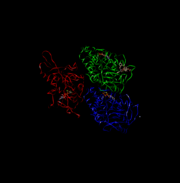Sandbox myosinkinesin
From Proteopedia
(Difference between revisions)
| Line 17: | Line 17: | ||
| - | '''''Heavy Chain''''' | + | '''''Heavy Chain:''''' |
It is the most conserved region amongst kinesin which consists of the head, neck, and tail. Usually contains eight core β-sheets and six major alpha helixes, most of these secondary structures are in different places in the primary sequence but line up in the tertiary structure. | It is the most conserved region amongst kinesin which consists of the head, neck, and tail. Usually contains eight core β-sheets and six major alpha helixes, most of these secondary structures are in different places in the primary sequence but line up in the tertiary structure. | ||
[[Image:Hirokawa.jpg | thumb | Here is a picture of the light chains.]] | [[Image:Hirokawa.jpg | thumb | Here is a picture of the light chains.]] | ||
| - | '''''Light Chain''''' | + | '''''Light Chain:''''' |
Not technically part of the protein of kinesin or myosin itself, but its presence is necessary for activity. It regulates conformational changes within the protein. | Not technically part of the protein of kinesin or myosin itself, but its presence is necessary for activity. It regulates conformational changes within the protein. | ||
[[Image:131631646354632.jpg | This is the overall structure of a functional kinesin dimer.]] | [[Image:131631646354632.jpg | This is the overall structure of a functional kinesin dimer.]] | ||
| - | '''Head''' | + | '''Head:''' |
Most conserved domain amongst all kinesin, it consists mainly of alpha helixes. Its tertiary structure usually includes a large cleft from the actin binding site to the ATP binding pocket. The head has the ability to bind microtubule on one site and bind ATP at another. This section undergoes the most conformational change and is responsible for the force that causes kinesin to move along the cytoskeleton. In kinesin, binding of ATP appears to have allosteric control over the binding of kinesin to the tubules, by a twisting of a β- sheet core, showing allosteric control between the subdomains within the protein. | Most conserved domain amongst all kinesin, it consists mainly of alpha helixes. Its tertiary structure usually includes a large cleft from the actin binding site to the ATP binding pocket. The head has the ability to bind microtubule on one site and bind ATP at another. This section undergoes the most conformational change and is responsible for the force that causes kinesin to move along the cytoskeleton. In kinesin, binding of ATP appears to have allosteric control over the binding of kinesin to the tubules, by a twisting of a β- sheet core, showing allosteric control between the subdomains within the protein. | ||
| Line 35: | Line 35: | ||
| - | '''Neck''' | + | '''Neck:''' |
completely alpha-helical region between the head and the tail on the heavy chain that binds to the light chains. | completely alpha-helical region between the head and the tail on the heavy chain that binds to the light chains. | ||
| Line 41: | Line 41: | ||
| - | '''Tail''' | + | '''Tail:''' |
Includes polypeptide binding site, varies the most since it is responsible for dictating the location within the cell that the protein is active. | Includes polypeptide binding site, varies the most since it is responsible for dictating the location within the cell that the protein is active. | ||
Revision as of 00:33, 16 December 2015
Kinesin
| |||||||||||
References
- ↑ Hanson, R. M., Prilusky, J., Renjian, Z., Nakane, T. and Sussman, J. L. (2013), JSmol and the Next-Generation Web-Based Representation of 3D Molecular Structure as Applied to Proteopedia. Isr. J. Chem., 53:207-216. doi:http://dx.doi.org/10.1002/ijch.201300024
- ↑ Herraez A. Biomolecules in the computer: Jmol to the rescue. Biochem Mol Biol Educ. 2006 Jul;34(4):255-61. doi: 10.1002/bmb.2006.494034042644. PMID:21638687 doi:10.1002/bmb.2006.494034042644



